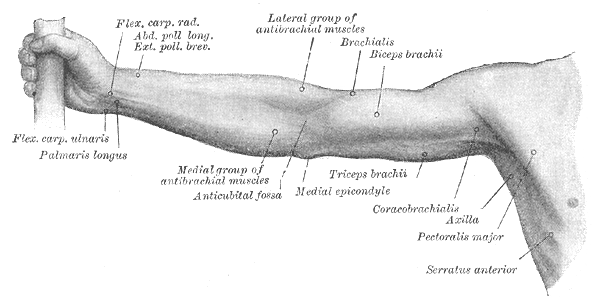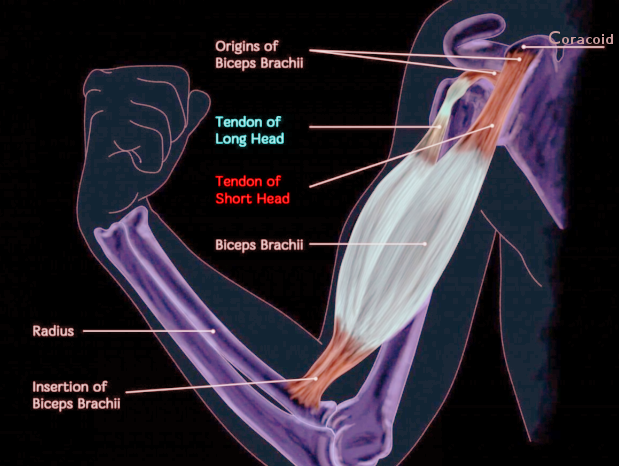[1]
Hutchinson HL, Gloystein D, Gillespie M. Distal biceps tendon insertion: an anatomic study. Journal of shoulder and elbow surgery. 2008 Mar-Apr:17(2):342-6
[PubMed PMID: 17931901]
[2]
Eames MH, Bain GI, Fogg QA, van Riet RP. Distal biceps tendon anatomy: a cadaveric study. The Journal of bone and joint surgery. American volume. 2007 May:89(5):1044-9
[PubMed PMID: 17473142]
[3]
Frank RM, Cotter EJ, Strauss EJ, Jazrawi LM, Romeo AA. Management of Biceps Tendon Pathology: From the Glenoid to the Radial Tuberosity. The Journal of the American Academy of Orthopaedic Surgeons. 2018 Feb 15:26(4):e77-e89. doi: 10.5435/JAAOS-D-17-00085. Epub
[PubMed PMID: 29337716]
[4]
van den Bekerom MP, Kodde IF, Aster A, Bleys RL, Eygendaal D. Clinical relevance of distal biceps insertional and footprint anatomy. Knee surgery, sports traumatology, arthroscopy : official journal of the ESSKA. 2016 Jul:24(7):2300-7. doi: 10.1007/s00167-014-3322-9. Epub 2014 Sep 18
[PubMed PMID: 25231429]
[5]
Créteur V, Madani A, Sattari A, El Kazzi W, Bianchi S. Ultrasonography of Complications in Surgical Repair of the Distal Biceps Brachii Tendon. Journal of ultrasound in medicine : official journal of the American Institute of Ultrasound in Medicine. 2019 Feb:38(2):499-512. doi: 10.1002/jum.14707. Epub 2018 Jul 19
[PubMed PMID: 30027585]
[6]
Saluja S, Das SS, Kumar D, Goswami P. Bilateral Three-headed Biceps Brachii Muscle and its Clinical Implications. International journal of applied & basic medical research. 2017 Oct-Dec:7(4):266-268. doi: 10.4103/ijabmr.IJABMR_339_16. Epub
[PubMed PMID: 29308368]
[7]
Moore CW, Rice CL. Rare muscular variations identified in a single cadaveric upper limb: a four-headed biceps brachii and muscular elevator of the latissimus dorsi tendon. Anatomical science international. 2018 Mar:93(2):311-316. doi: 10.1007/s12565-017-0408-8. Epub 2017 Jul 6
[PubMed PMID: 28685367]
[8]
Busconi BB, DeAngelis N, Guerrero PE. The proximal biceps tendon: tricks and pearls. Sports medicine and arthroscopy review. 2008 Sep:16(3):187-94. doi: 10.1097/JSA.0b013e318183c134. Epub
[PubMed PMID: 18703980]
[9]
Neer CS 2nd. Anterior acromioplasty for the chronic impingement syndrome in the shoulder. 1972. The Journal of bone and joint surgery. American volume. 2005 Jun:87(6):1399
[PubMed PMID: 15930554]
[10]
Jobe FW, Moynes DR, Tibone JE, Perry J. An EMG analysis of the shoulder in pitching. A second report. The American journal of sports medicine. 1984 May-Jun:12(3):218-20
[PubMed PMID: 6742305]
[11]
Alpantaki K, McLaughlin D, Karagogeos D, Hadjipavlou A, Kontakis G. Sympathetic and sensory neural elements in the tendon of the long head of the biceps. The Journal of bone and joint surgery. American volume. 2005 Jul:87(7):1580-3
[PubMed PMID: 15995126]
[12]
Mazzocca AD, McCarthy MB, Ledgard FA, Chowaniec DM, McKinnon WJ Jr, Delaronde S, Rubino LJ, Apolostakos J, Romeo AA, Arciero RA, Beitzel K. Histomorphologic changes of the long head of the biceps tendon in common shoulder pathologies. Arthroscopy : the journal of arthroscopic & related surgery : official publication of the Arthroscopy Association of North America and the International Arthroscopy Association. 2013 Jun:29(6):972-81. doi: 10.1016/j.arthro.2013.02.002. Epub 2013 Apr 6
[PubMed PMID: 23571131]
[13]
Alexander JG, de Fúcio Lizardo JH, da Silva Baptista J. Multiple arterial variations in the upper limb: description and clinical relevance. Anatomical science international. 2021 Mar:96(2):310-314. doi: 10.1007/s12565-020-00569-5. Epub 2020 Sep 9
[PubMed PMID: 32909194]
[14]
Benes M, Kachlik D, Lev D, Kunc V. Accessory heads of the biceps brachii muscle: A systematic review and meta-analysis. Journal of anatomy. 2022 Aug:241(2):461-477. doi: 10.1111/joa.13666. Epub 2022 Apr 12
[PubMed PMID: 35412670]
Level 1 (high-level) evidence
[15]
El Abiad JM, Faddoul DG, Baydoun H. Case report: Broad insertion of a large subscapularis tendon in association with congenital absence of the long head of the biceps tendon. Skeletal radiology. 2019 Jan:48(1):159-162. doi: 10.1007/s00256-018-2989-2. Epub 2018 Jun 12
[PubMed PMID: 29948038]
Level 3 (low-level) evidence
[16]
Lafosse L, Reiland Y, Baier GP, Toussaint B, Jost B. Anterior and posterior instability of the long head of the biceps tendon in rotator cuff tears: a new classification based on arthroscopic observations. Arthroscopy : the journal of arthroscopic & related surgery : official publication of the Arthroscopy Association of North America and the International Arthroscopy Association. 2007 Jan:23(1):73-80
[PubMed PMID: 17210430]
[17]
Martetschläger F, Tauber M, Habermeyer P. Injuries to the Biceps Pulley. Clinics in sports medicine. 2016 Jan:35(1):19-27. doi: 10.1016/j.csm.2015.08.003. Epub 2015 Sep 26
[PubMed PMID: 26614466]
[18]
Kongmalai P. Arthroscopic extra-articular suprapectoral biceps tenodesis with knotless suture anchor. European journal of orthopaedic surgery & traumatology : orthopedie traumatologie. 2019 Feb:29(2):493-497. doi: 10.1007/s00590-018-2301-0. Epub 2018 Aug 25
[PubMed PMID: 30145670]


